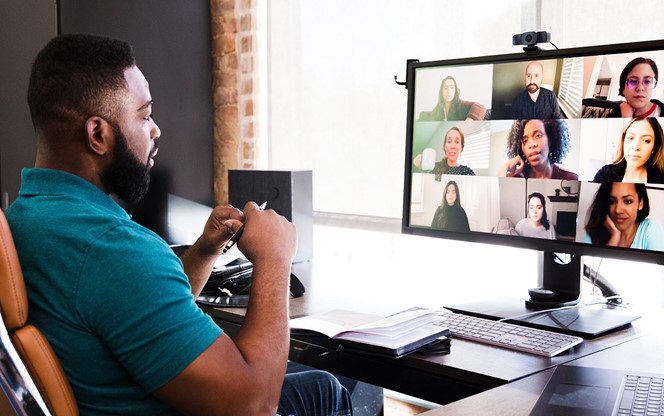

Archived Insight | January 22, 2021
The COVID-19 pandemic has brought unprecedented changes to the world of work. Restrictions on travel and in-person interactions led many organizations to shift their workforces to remote work in a matter of weeks. For sectors where remote work is not an option, such as manufacturing and construction, organizations embraced technology and adjusted schedules to ensure workers’ safety.

Share this page
To maintain operations and support a newly dispersed workforce during the COVID-19 pandemic, organizations have fast-tracked adoption and investment in modern technology. In June 2020, McKinsey reported 85 percent of global executives somewhat or greatly accelerated the implementation of modern technologies to enable employee interaction and collaboration.
While workers are adapting to connecting with colleagues via videoconferencing and cloud collaboration, workplace technology needs to go beyond conference calls and shared documents. Hybrid remote and in-person work models need thoughtful redesign to be successful. Organizations are looking to new and immersive technologies to support those models, create efficiencies and build culture without overwhelming workers.
 For many, remote work will continue long after the pandemic recedes. In June, Gartner reported 82% of organizations surveyed plans to allow remote working at least some of the time when employees return to the workplace. Nearly half (47 percent) of company leaders said they plan to permit employees to work remotely full time. This will require a shift in technology, policies and culture that will have both benefits and drawbacks.
For many, remote work will continue long after the pandemic recedes. In June, Gartner reported 82% of organizations surveyed plans to allow remote working at least some of the time when employees return to the workplace. Nearly half (47 percent) of company leaders said they plan to permit employees to work remotely full time. This will require a shift in technology, policies and culture that will have both benefits and drawbacks.
While remote working offers flexibility and access to a broad talent pool, many workers and organizations miss the opportunities to build relationships that naturally come from sharing a physical space. Building a sense of belonging in the workplace is not only vital to employee experience, it’s also important to an organization’s bottom line.
Employees who feel a strong sense of belonging at work report a 56 percent higher level of job performance and take 75 percent fewer sick days, according to a 2019 study from BetterUp. Belonging is also associated with a 50 percent reduction in turnover risk. As workers adapt to new ways of working, organizations are exploring new and better ways to use technology to build inclusivity, autonomy and trust.
Artificial intelligence and extended reality technologies (such as virtual, augmented and mixed) that create an immersive experience can reduce operating costs and transform the way employees work and interact. By 2030, nearly 23.5 million jobs globally will use augmented and virtual reality, according to a 2019 PwC report. A host of new and immersive technologies can build connections, enhance learning and automate routine tasks.
 Artificial intelligence and machine learning can close skills gaps and improve employee productivity. They can also facilitate relationship building. AI-enabled scheduling can identify people working on similar projects and across teams and create meetings for them to collaborate.
Artificial intelligence and machine learning can close skills gaps and improve employee productivity. They can also facilitate relationship building. AI-enabled scheduling can identify people working on similar projects and across teams and create meetings for them to collaborate.
Adding gamification — where workers earn rewards or prizes for completing tasks — can drive engagement, promote learning and keep employees motivated. It can also make work more fun. Leaderboards and challenges can reinforce company culture and help employees feel more involved with the organization.
Virtual reality (VR) can promote connection and collaboration. Using virtual reality headsets or goggles, team members in different locations interact with each other in the same space. Instead of a grid of faces on a screen, individuals have the ability to move around a virtual space to interact, share 3D products or have side conversations.
Unlike video conferencing, interactions aren’t limited to what appears on a computer screen. VR enhances onboarding for new hires by introducing them to the organization’s culture and providing a virtual workplace tour. The technology mimics real-world collaborations to help build workplace relationships among employees who may feel disconnected from each other and the organization.
 Augmented reality (AR) can help employees learn a new task by providing on-demand, remote assistance. AR enhances the real world with digital elements such as text or 3-D objects through a mobile device or headset. Industries such as healthcare and manufacturing use AR for training and delivering information to enhance and accelerate experiential learning.
Augmented reality (AR) can help employees learn a new task by providing on-demand, remote assistance. AR enhances the real world with digital elements such as text or 3-D objects through a mobile device or headset. Industries such as healthcare and manufacturing use AR for training and delivering information to enhance and accelerate experiential learning.
Mixed reality (MR), which combines elements of both AR and VR, allow real world and digital objects to interact. In engineering, MR technologies create 3-D models in a virtual environment. The applications support collaboration by bringing teams together in virtual offices. In the education and health care industries, MR plays an important role in training and interactive learning.
 While virtual personal assistants such as Apple’s Siri and Amazon’s Alexa are widely used by consumers to manage smart devices at home, there is growing interest in using digital assistants to support work. Gartner predicts 25 percent of workers will use digital assistants in 2021, up from less than 2 percent in 2019.
While virtual personal assistants such as Apple’s Siri and Amazon’s Alexa are widely used by consumers to manage smart devices at home, there is growing interest in using digital assistants to support work. Gartner predicts 25 percent of workers will use digital assistants in 2021, up from less than 2 percent in 2019.
Rather than replace workers, virtual digital assistants can help employees do their jobs more efficiently. Employees can use virtual digital assistants to schedule meetings, create documents, manage to-do lists, and improve analysis.
Unlike rules-based chatbots that follow predefined workflows, AI-driven assistants use natural language processing and machine learning to provide more human-like interactions. HR virtual assistants interact with employees to provide real-time responses to questions. With onboarding, virtual digital assistants guide new hires through common tasks, recommend training and learning opportunities and provide a “virtual buddy” to answer questions.
Using these tools can boost the employee experience by providing consistent support, information and customized messages. The data captured from these activities can improve processes and help assess program effectiveness.
Evaluating the adoption of any new technology requires an organization to consider the benefits, costs, and risks to both the enterprise and its workforce. Top of mind with any new technology is ensuring cybersecurity and privacy protections. Immersive technologies are vulnerable to digital threats and unauthorized access. Data collected by VR or AR devices can raise concerns about personal privacy. Organizations worried about these threats should hire risk and audit professionals to evaluate these vulnerabilities, which will help guide investment decisions.
A comprehensive implementation strategy is critical. This includes creating use policies, providing training, and communicating the benefits of the technology and how it will be used. The strategy should also include ongoing support from IT professionals skilled in device configuration, activation and management.
COVID-19 should continue to drive demand for immersive technologies. With increased demand, costs are likely to fall, creating opportunities for more organizations to adopt these tools. For organizations hesitant to invest in new technologies, the pandemic has demonstrated both the need for these tools and a willingness by workers to learn new skills.
The future of work has always been about flexibility and fluid workforces (see our insights on the Future of Work). Virtual workspaces and the use of immersive technologies can support these transformations. They can increase operational efficiency and help forge connections between coworkers and the organization. By implementing new ways to interact, collaborate and learn, organizations can become more agile, scale faster and improve engagement.
We're here with plenty of answers! Leave your contact information and someone will reach out to start a conversation.

Technology, Benefits Administration, Communications, Multiemployer Plans, Public Sector, Healthcare Industry, Higher Education, Architecture Engineering & Construction, Consulting Innovation, Corporate, Benefits Technology, ATC, Organizational Effectiveness, Health, Retirement

Health, Compliance, Multiemployer Plans, Public Sector, Healthcare Industry, Higher Education, Architecture Engineering & Construction, Corporate

Compliance, Health, Higher Education, Healthcare Industry, Corporate, Architecture Engineering & Construction
This page is for informational purposes only and does not constitute legal, tax or investment advice. You are encouraged to discuss the issues raised here with your legal, tax and other advisors before determining how the issues apply to your specific situations.
© 2026 by The Segal Group, Inc.Terms & Conditions Privacy Policy Style Guide California Residents Sitemap Disclosure of Compensation Required Notices